Evaluation of the Use of Permeable Interlocking Concrete Pavement in Chile: Urban Infrastructure Solution for Adaptation and Mitigation against Climate Change
Abstract
:1. Introduction
1.1. Urban Context of Stormwater Management Considering Climate Change
1.2. Urban Stormwater Management Infrastructure: Permeable Interlocking Concrete Paving
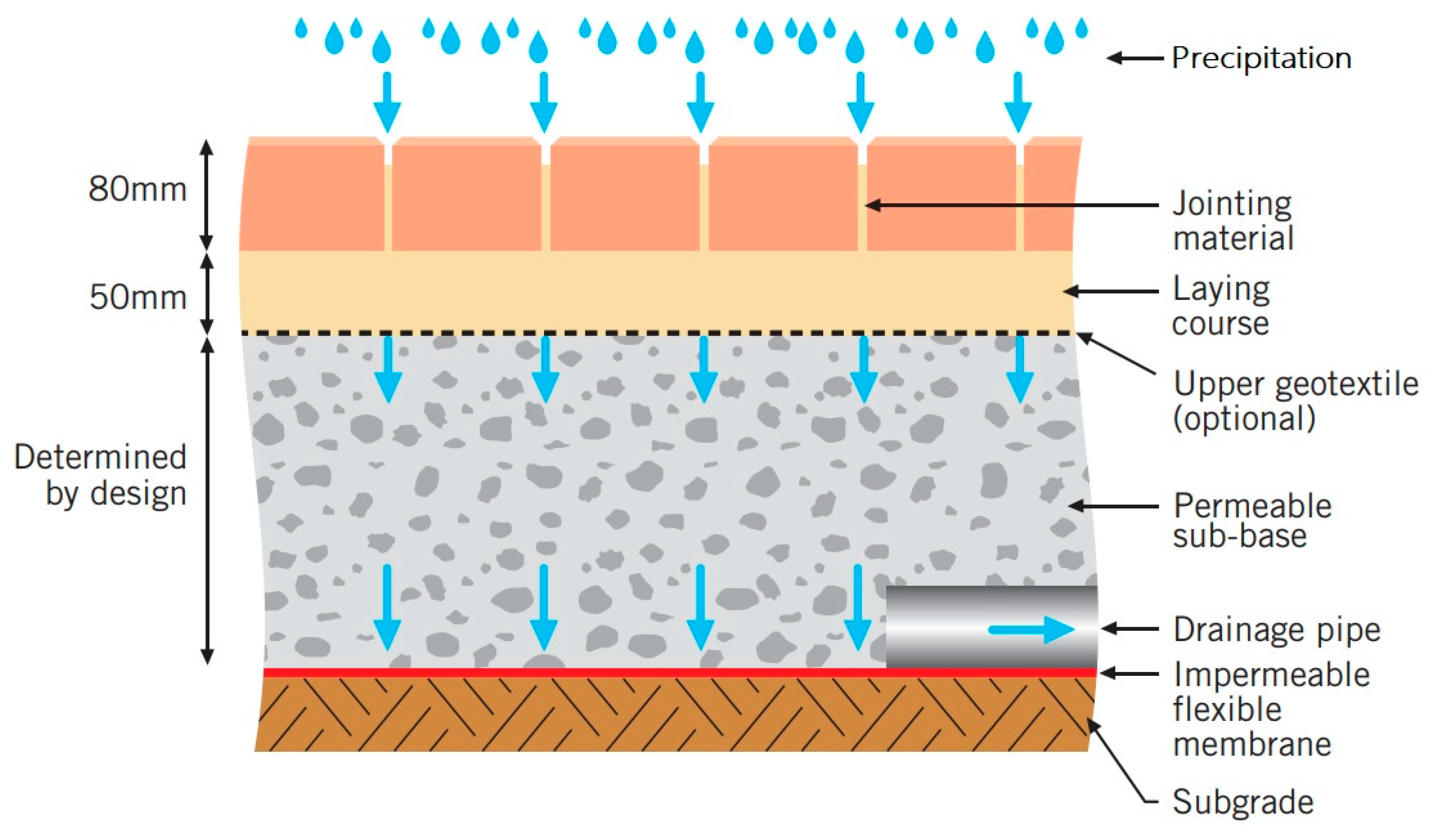
1.3. Urban Stormwater Management Problems in Chile
1.4. Aim of the Article
- Identify the structural behavior of the design layers that make up a permeable interlocking concrete paving system.
- Demonstrate the performance of a permeable interlocking concrete paving system through physical–mathematical modeling addressing the construction development that its implementation entails.
- Evaluate the feasibility of using permeable interlocking concrete in the city of Temuco, La Araucanía region, Chile, considering historical precipitation records under a climate change scenario.
- Propose the use of new technologies in urban drainage paving systems to improve urban sustainability.
2. Materials and Methods
2.1. Research Type and Design
2.2. Research Material Resources
2.3. Software: Permeable Design Pro
2.4. Study Area Location
2.5. Study Area Characteristics and Sample Selection
2.6. Hydrologic–Hydraulic Analysis for Permeable Interlocking Concrete Pavement
2.6.1. Water Balance
2.6.2. Stormwater Inflow
2.6.3. Stormwater Drainage System
3. Results
3.1. Structural Layer Design of Permeable Interlocking Concrete Pavement (PICP)
3.2. Typical Cross-Section of Structure of Permeable Interlocking Concrete Pavement (PICP)
3.3. Water Balance Results—Drainage Pipe with Smooth Roughness Coefficient
3.4. Water Balance Results—Drainage Pipe with Corrugated Roughness Coefficient
3.5. Hydrological Evaluation Results—Drainage Pipe with Smooth Roughness Coefficient
3.6. New Sustainable Approaches to the Urban Management of Stormwater
4. Discussion
5. Conclusions
Author Contributions
Funding
Data Availability Statement
Conflicts of Interest
Abbreviations
| PICP | Permeable interlocking concrete pavement |
| SUDSs | Sustainable drainage systems |
| SDGs | Sustainable development goals |
| FUA | Functional urban areas |
| ICPI | Interlocking Concrete Pavement Institute |
| AASHTO | American Association of State Highway and Transportation Officials |
| ABCP | Brazilian Portland Cement Association |
| masl | Meters above sea level |
References
- Kováč, M.; Sičáková, A. Pervious concrete as an environmental solution for pavements: Focus on key properties. Environments 2018, 5, 11. [Google Scholar] [CrossRef]
- Rahman, M.A.; Hossain, M.Z.; Rahaman, K.R. Climate Urbanism as a New Urban Development Paradigm: Evaluating a City’s Progression towards Climate Urbanism in the Global South. Climate 2023, 11, 159. [Google Scholar] [CrossRef]
- Mena, C.F.; Benitez, F.L.; Sampedro, C.; Martinez, P.; Quispe, A.; Laituri, M. Modeling Urban Growth and the Impacts of Climate Change: The Case of Esmeraldas City, Ecuador. Sustainability 2022, 14, 4704. [Google Scholar] [CrossRef]
- Janiszek, M.; Krzysztofik, R. Green Infrastructure as an Effective Tool for Urban Adaptation—Solutions from a Big City in a Postindustrial Region. Sustainability 2023, 15, 8928. [Google Scholar] [CrossRef]
- Boulanger, S.O.M. Urban Adaptation to Climate Change State of the Art: Evaluating the Role of Adaptation Assessment Frameworks through a Systematic and Bibliometric Analysis. Sustainability 2023, 15, 10134. [Google Scholar] [CrossRef]
- Hu, Q.; He, X.; Zhu, H.; Yang, P. Understanding Residents’ Intention to Adapt to Climate Change in Urban Destinations—A Case Study of Chang-Zhu-Tan Urban Agglomeration. Sustainability 2023, 15, 12408. [Google Scholar] [CrossRef]
- Instituto Nacional Estadísticas (INE). Síntesis de Resultados Censo 2017; National Statistics Institute: Santiago, Chile, 2018. [Google Scholar]
- Zhou, Q. A review of sustainable urban drainage systems considering the climate change and urbanization impacts. Water 2014, 6, 976–992. [Google Scholar] [CrossRef]
- Rezvani, S.M.H.S.; de Almeida, N.M.; Falcão, M.J. Climate Adaptation Measures for Enhancing Urban Resilience. Buildings 2023, 13, 2163. [Google Scholar] [CrossRef]
- Thodesen, B.; Time, B.; Kvande, T. Sustainable Urban Drainage Systems: Themes of Public Perception—A Case Study. Land 2022, 11, 589. [Google Scholar] [CrossRef]
- Gato-Trinidad, S. Special Issue: Stormwater/Drainage Systems and Wastewater Management. Hydrology 2023, 10, 124. [Google Scholar] [CrossRef]
- Ramísio, P.J.; Brito, R.S.; Beceiro, P. Accessing Synergies and Opportunities between Nature-Based Solutions and Urban Drainage Systems. Sustainability 2022, 14, 16906. [Google Scholar] [CrossRef]
- Velasco, M.; Russo, B.; Martínez-Gomariz, E. Integrated Assessment of Climate Change Impacts and Urban Resilience: From Climate and Hydrological Hazards to Risk Analysis and Measures. Sustainability 2020, 12, 6430. [Google Scholar] [CrossRef]
- Sambito, M.; Severino, A.; Freni, G.; Neduzha, L. A Systematic review of the hydrological, environmental and durability performance of permeable pavement systems. Sustainability 2021, 13, 4509. [Google Scholar] [CrossRef]
- Lähde, E.; Khadka, A.; Tahvonen, O.; Kokkonen, T. Can we really have it all?—Designing multifunctionality with sustainable urban drainage system elements. Sustainability 2019, 11, 1854. [Google Scholar] [CrossRef]
- Shafique, M.; Kim, R. Green stormwater infrastructure with low impact development concept: A review of current research. Desalin. Water Treat. 2017, 83, 16–29. [Google Scholar] [CrossRef]
- Jiang, Y.; Hou, L.; Shi, T.; Gui, Q. A Review of Urban Planning Research for Climate Change. Sustainability 2017, 9, 2224. [Google Scholar] [CrossRef]
- Mariano, C.; Marino, M. Urban Planning for Climate Change: A Toolkit of Actions for an Integrated Strategy of Adaptation to Heavy Rains, River Floods, and Sea Level Rise. Urban Sci. 2022, 6, 63. [Google Scholar] [CrossRef]
- de Oliveira, A.K.B.; Battemarco, B.P.; Barbaro, G.; Gomes, M.V.R.; Cabral, F.M.; Bezerra, R.d.O.P.; Rutigliani, V.d.A.; Lourenço, I.B.; Machado, R.K.; Rezende, O.M.; et al. Evaluating the Role of Urban Drainage Flaws in Triggering Cascading Effects on Critical Infrastructure, Affecting Urban Resilience. Infrastructures 2022, 7, 153. [Google Scholar] [CrossRef]
- Ghisi, E.; Belotto, T.; Thives, L.P. The use of permeable interlocking concrete pavement to filter stormwater for non-potable uses in buildings. Water 2020, 12, 2045. [Google Scholar] [CrossRef]
- Liu, B.K.; Armitage, N.P. The link between permeable interlocking concrete pavement (PICP) design and nutrient removal. Water 2020, 12, 1714. [Google Scholar] [CrossRef]
- Iqbal, A.; Rahman, M.; Beecham, S. Permeable Pavements for Flood Control in Australia: Spatial Analysis of Pavement Design Considering Rainfall and Soil Data. Sustainability 2022, 14, 4970. [Google Scholar] [CrossRef]
- Coughlin, J.P.; Campbell, C.D.; Mays, D.C. Infiltration and clogging by sand and clay in a pervious concrete pavement system. J. Hydrol. Eng. 2012, 17, 68–73. [Google Scholar] [CrossRef]
- Anwar, F.H.; El-Hassan, H.; Hamouda, M.; Hinge, G.; Mo, K.H. Meta-Analysis of the Performance of Pervious Concrete with Cement and Aggregate Replacements. Buildings 2022, 12, 461. [Google Scholar] [CrossRef]
- Park, J.; Park, J.; Cheon, J.; Lee, J.; Shin, H. Analysis of infiltrating water characteristics of permeable pavements in a parking lot at full scale. Water 2020, 12, 2081. [Google Scholar] [CrossRef]
- Scholz, M.; Grabowiecki, P. Review of porous pavement systems. Build. Environ. 2007, 42, 3830–3836. [Google Scholar] [CrossRef]
- Yang, Q.; Gao, Z.; Beecham, S. A Sustainable Approach to Cleaning Porous and Permeable Pavements. Sustainability 2022, 14, 14583. [Google Scholar] [CrossRef]
- Ranieri, V. Runoff control in porous pavements. Transp. Res. Rec. 2002, 1789, 46–55. [Google Scholar] [CrossRef]
- Vaz, I.C.M.; Ghisi, E.; Thives, L.P. Stormwater harvested from permeable pavements as a means to save potable water in buildings. Water 2021, 13, 1896. [Google Scholar]
- Interpave. Guide to the Design, Construction and Maintenance of Concrete Block Permeable Pavements. 2010. Available online: www.paving.org.uk (accessed on 11 November 2023).
- Aldunce, P.; Araya, D.; Sapiain, R.; Ramos, I.; Lillo, G.; Urquiza, A.; Garreaud, R. Local perception of drought impacts in a changing climate: The mega-drought in central Chile. Sustainability 2017, 9, 2053. [Google Scholar] [CrossRef]
- Álvez, A.; Espinosa, P.; Castillo, R.; Iglesias, K.; Bañales-Seguel, C. An Urgent Dialogue between Urban Design and Regulatory Framework for Urban Rivers: The Case of the Andalién River in Chile. Water 2022, 14, 3444. [Google Scholar] [CrossRef]
- Winckler, P.; Contreras-López, M.; Garreaud, R.; Meza, F.; Larraguibel, C.; Esparza, C.; Gelcich, S.; Falvey, M.; Mora, J. Analysis of Climate-Related Risks for Chile’s Coastal Settlements in the ARClim Web Platform. Water 2022, 14, 3594. [Google Scholar] [CrossRef]
- Direccion General de Aguas (DGA); Ministerio de Obras Publicas de Chile (MOP). Estadísticas Datos Fluviométricos y Meteorológicos Estaciones de Monitoreo DGA. Available online: https://dga.mop.gob.cl/servicioshidrometeorologicos/Paginas/default.aspx (accessed on 11 November 2023).
- ICPI. Permeable Design Pro Software; ICPI: Herndon, VA, USA, 2019. [Google Scholar]
- Lee, M.-G.; Wang, W.-C.; Wang, Y.-C.; Hsieh, Y.-C.; Lin, Y.-C. Mechanical Properties of High-Strength Pervious Concrete with Steel Fiber or Glass Fiber. Buildings 2022, 12, 620. [Google Scholar] [CrossRef]
- Ho, H.-L.; Huang, R.; Hwang, L.-C.; Lin, W.-T.; Hsu, H.-M. Waste-based pervious concrete for climate-resilient pavements. Materials 2018, 11, 900. [Google Scholar] [CrossRef]
- Lu, G.; Wang, Y.; Li, H.; Wang, D.; Oeser, M. The environmental impact evaluation on the application of permeable pavement based on life cycle analysis. Int. J. Transp. Sci. Technol. 2019, 8, 351–357. [Google Scholar] [CrossRef]
- Concrete Masonry Association of Australia. Permeable Interlocking Concrete Pavements-Design and Construction Guide. 2010. Available online: www.cmaa.com.au (accessed on 2 September 2023).
- ICPI. Permeable Interlocking Concrete Pavements Drawings. Available online: https://icpi.org/permeable-interlocking-concrete-pavement-drawings (accessed on 11 November 2023).
- Liu, Y.; Sang, M.; Xu, X.; Shen, L.; Bao, H. How Can Urban Regeneration Reduce Carbon Emissions? A Bibliometric Review. Land 2023, 12, 1328. [Google Scholar] [CrossRef]
- Short, J.R.; Farmer, A. Cities and Climate Change. Earth 2021, 2, 1038–1045. [Google Scholar] [CrossRef]
- Solé, J. Climate and Energy Crises from the Perspective of the Intergovernmental Panel on Climate Change: Trade-Offs between Systemic Transition and Societal Collapse? Sustainability 2023, 15, 2231. [Google Scholar] [CrossRef]
- Jamali, A.; Robati, M.; Nikoomaram, H.; Farsad, F.; Aghamohammadi, H. Urban Resilience and Climate Change: Developing a Multidimensional Index to Adapt against Climate Change in the Iranian Capital City of Tehran. Urban Sci. 2023, 7, 7. [Google Scholar] [CrossRef]
- Makvandi, M.; Li, W.; Ou, X.; Chai, H.; Khodabakhshi, Z.; Fu, J.; Yuan, P.F. Urban Heat Mitigation towards Climate Change Adaptation: An Eco-Sustainable Design Strategy to Improve Environmental Performance under Rapid Urbanization. Atmosphere 2023, 14, 638. [Google Scholar] [CrossRef]
- Ortiz, A.; Velasco, M.J.; Esbri, O.; Medina, V.; Russo, B. The economic impact of climate change on urban drainage master planning in barcelona. Sustainability 2021, 13, 71. [Google Scholar] [CrossRef]
- Beceiro, P.; Galvão, A.; Brito, R.S. Resilience assessment framework for nature based solutions in stormwater management and control: Application to cities with different resilience maturity. Sustainability 2020, 12, 10040. [Google Scholar] [CrossRef]
- Fernández, C.G.; Peek, D. Smart and sustainable? positioning adaptation to climate change in the European smart city. Smart Cities 2020, 3, 511–526. [Google Scholar] [CrossRef]
- Meerow, S.; Stults, M. Comparing conceptualizations of urban climate resilience in theory and practice. Sustainability 2016, 8, 701. [Google Scholar] [CrossRef]
- Marí-Dell’olmo, M.; Oliveras, L.; Barón-Miras, L.E.; Borrell, C.; Montalvo, T.; Ariza, C.; Ventayol, I.; Mercuriali, L.; Sheehan, M.; Gómez-Gutiérrez, A.; et al. Climate Change and Health in Urban Areas with a Mediterranean Climate: A Conceptual Framework with a Social and Climate Justice Approach. Int. J. Environ. Res. Public Health 2022, 19, 12764. [Google Scholar] [CrossRef] [PubMed]
- Francisco, T.H.S.; Menezes, O.V.C.; Guedes, A.L.A.; Maquera, G.; Neto, D.C.V.; Longo, O.C.; Chinelli, C.K.; Soares, C.A.P. The Main Challenges for Improving Urban Drainage Systems from the Perspective of Brazilian Professionals. Infrastructures 2023, 8, 5. [Google Scholar] [CrossRef]
- di Toro, D.M.; Small, M.J. Stormwater Interception and Storage. J. Environ. Eng. Div. 1979, 105, 43–54. [Google Scholar] [CrossRef]
- He, C.; Zhou, L.; Ma, W.; Wang, Y. Spatial Assessment of Urban Climate Change Vulnerability during Different Urbanization Phases. Sustainability 2019, 11, 2406. [Google Scholar] [CrossRef]
- Andrés-Doménech, I.; Anta, J.; Perales-Momparler, S.; Rodriguez-Hernandez, J. Sustainable urban drainage systems in Spain: A diagnosis. Sustainability 2021, 13, 2791. [Google Scholar] [CrossRef]
- OpenAI. DALL-E-2. Available online: https://openai.com/dall-e-2 (accessed on 25 September 2023).
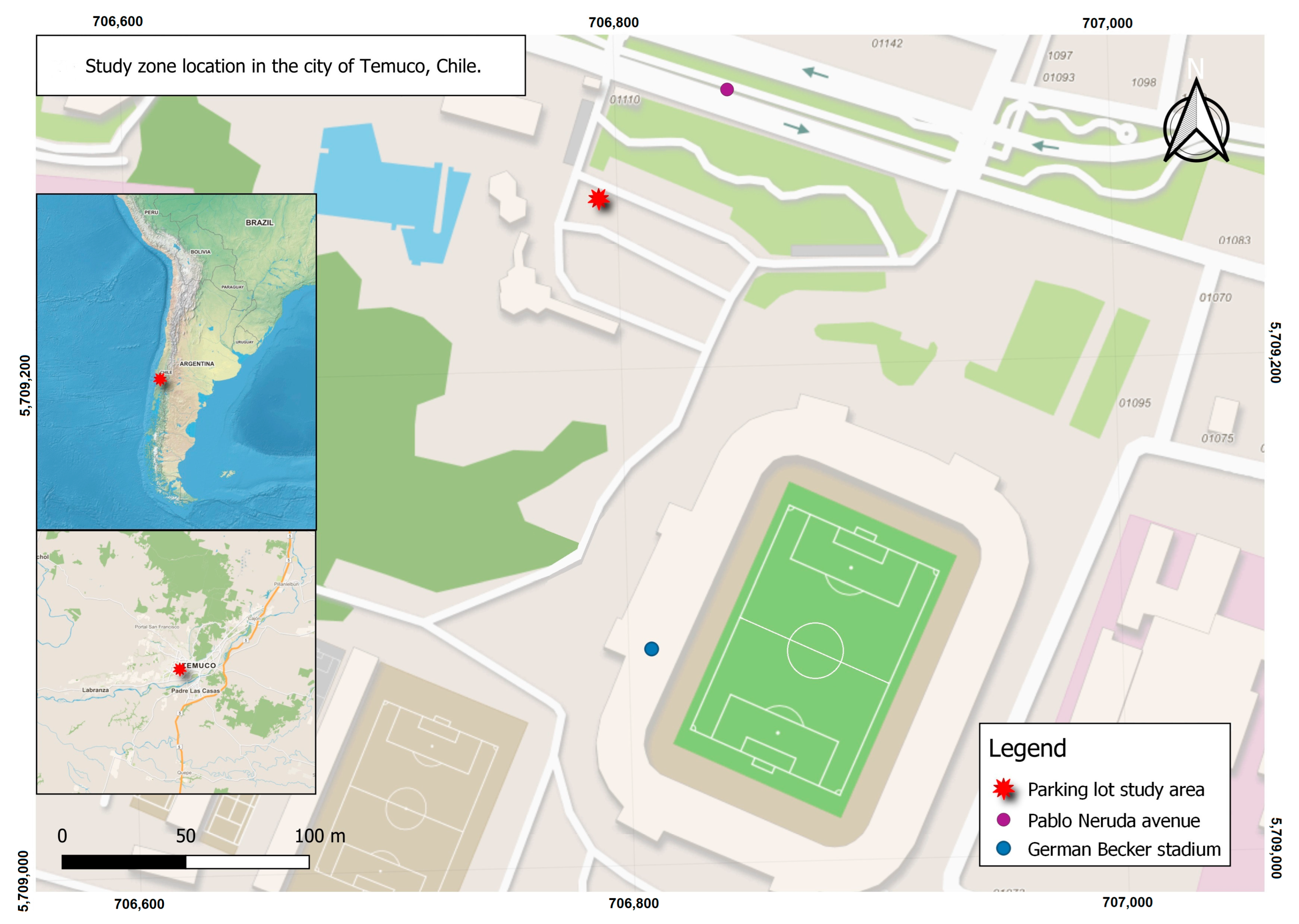
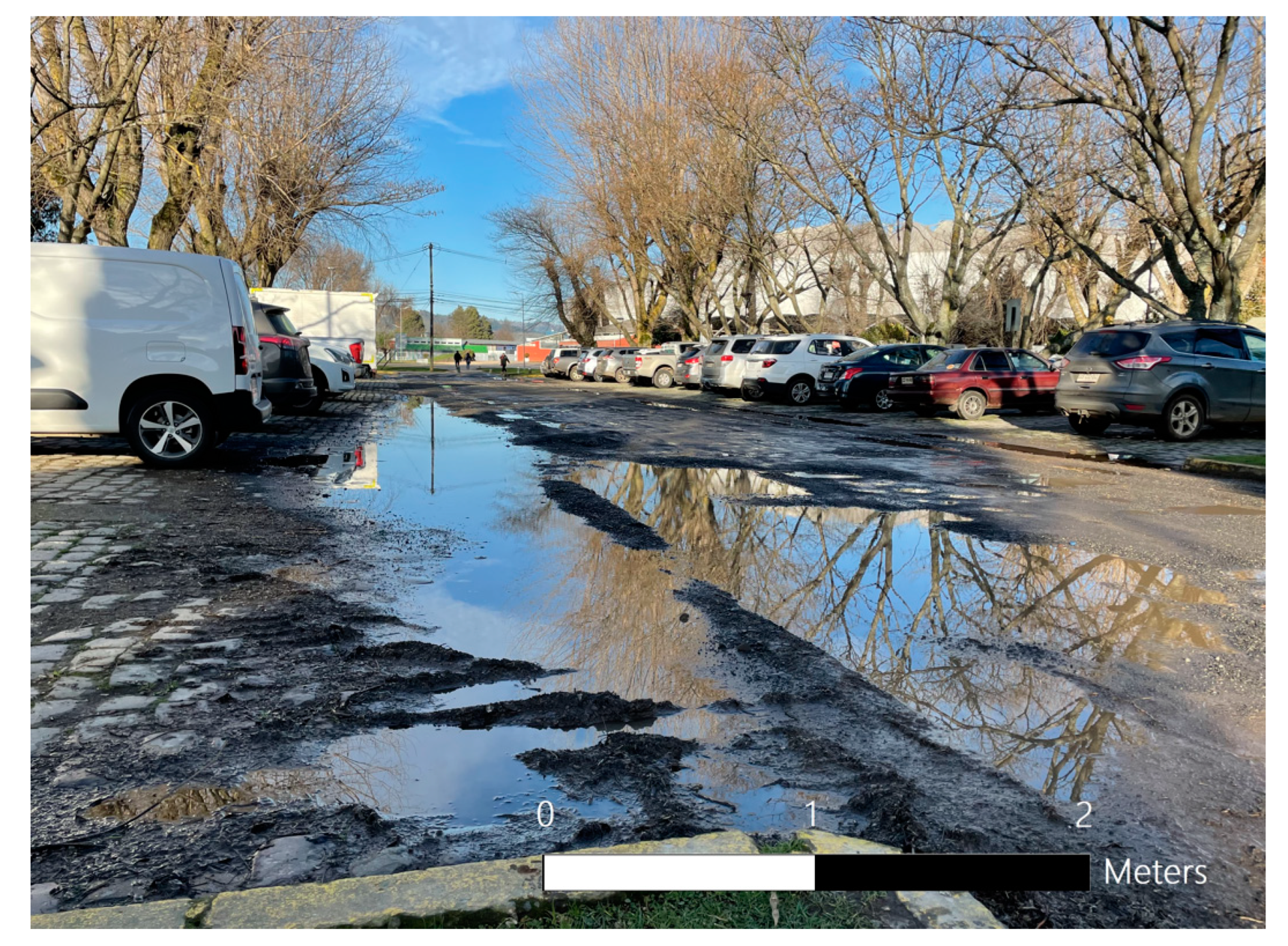
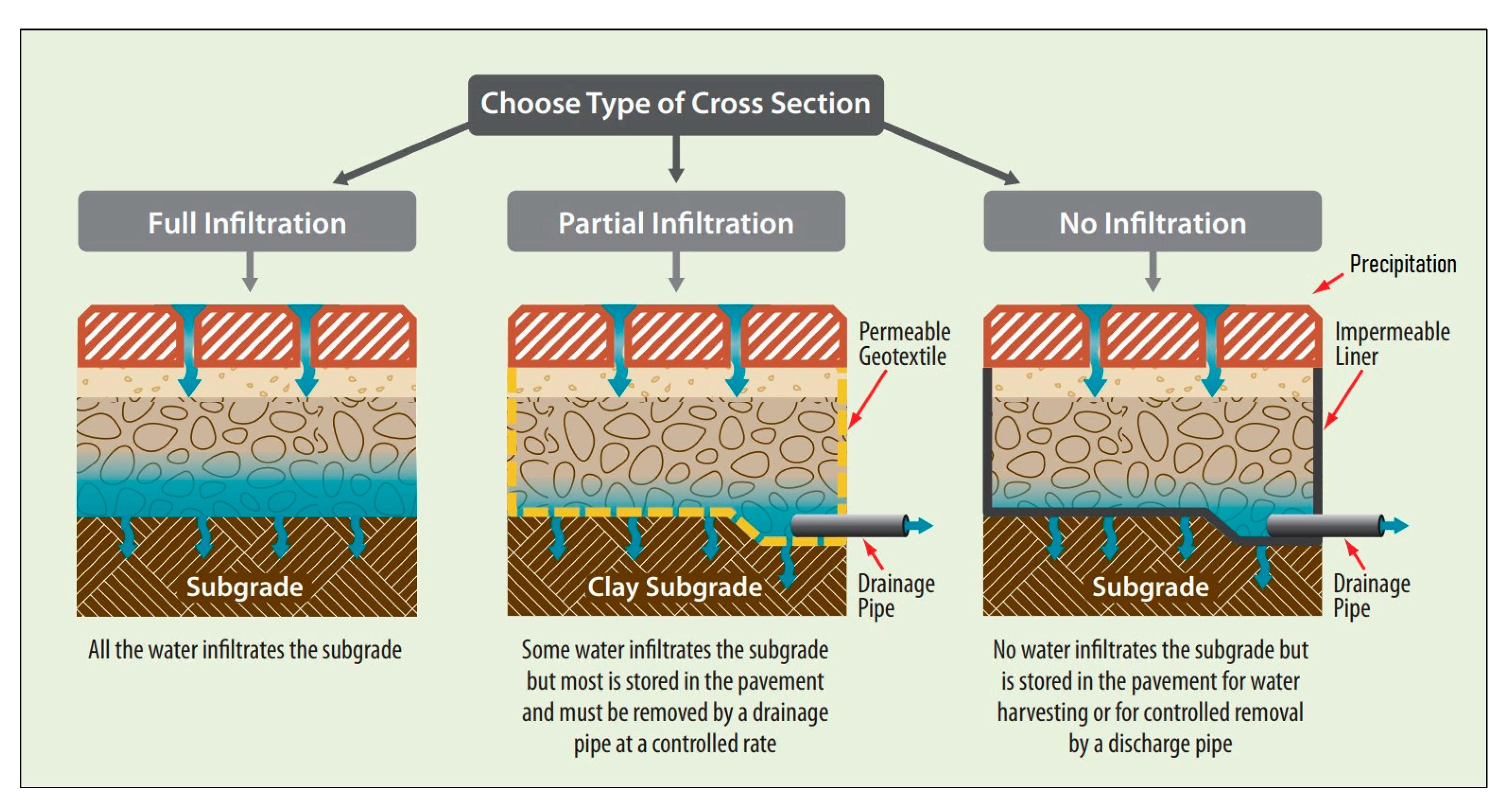

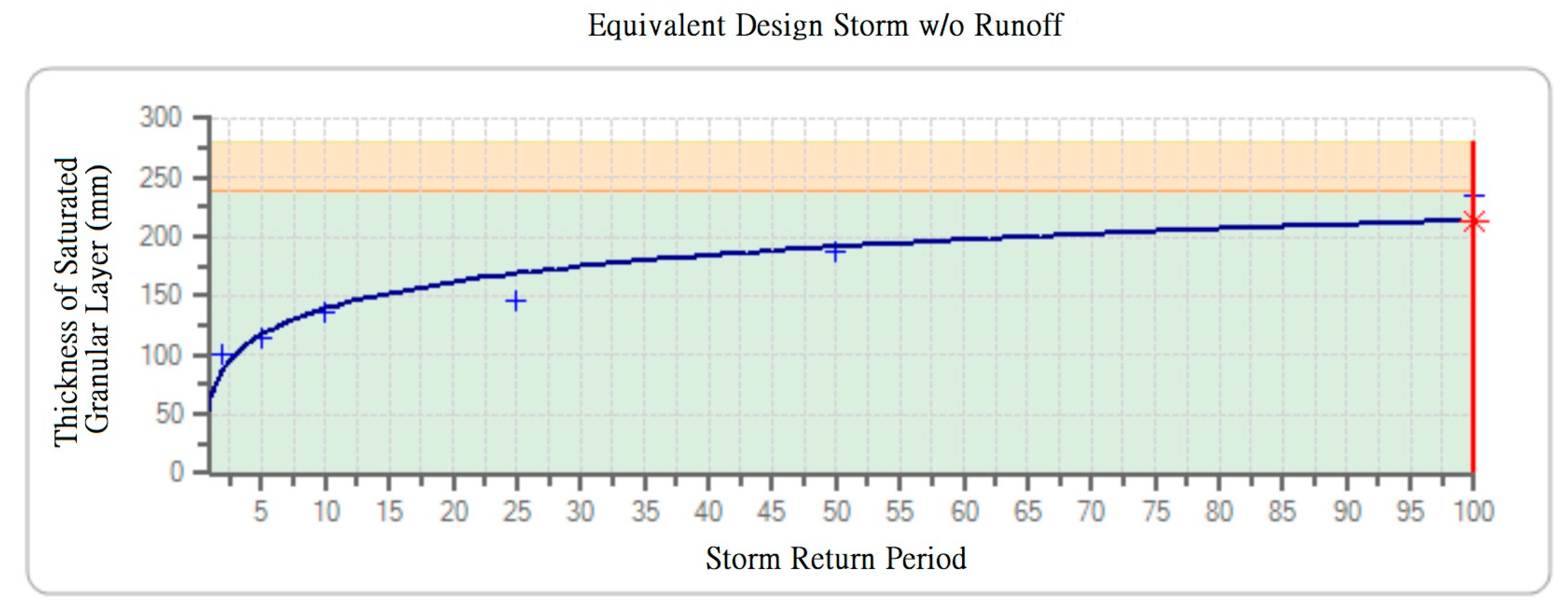

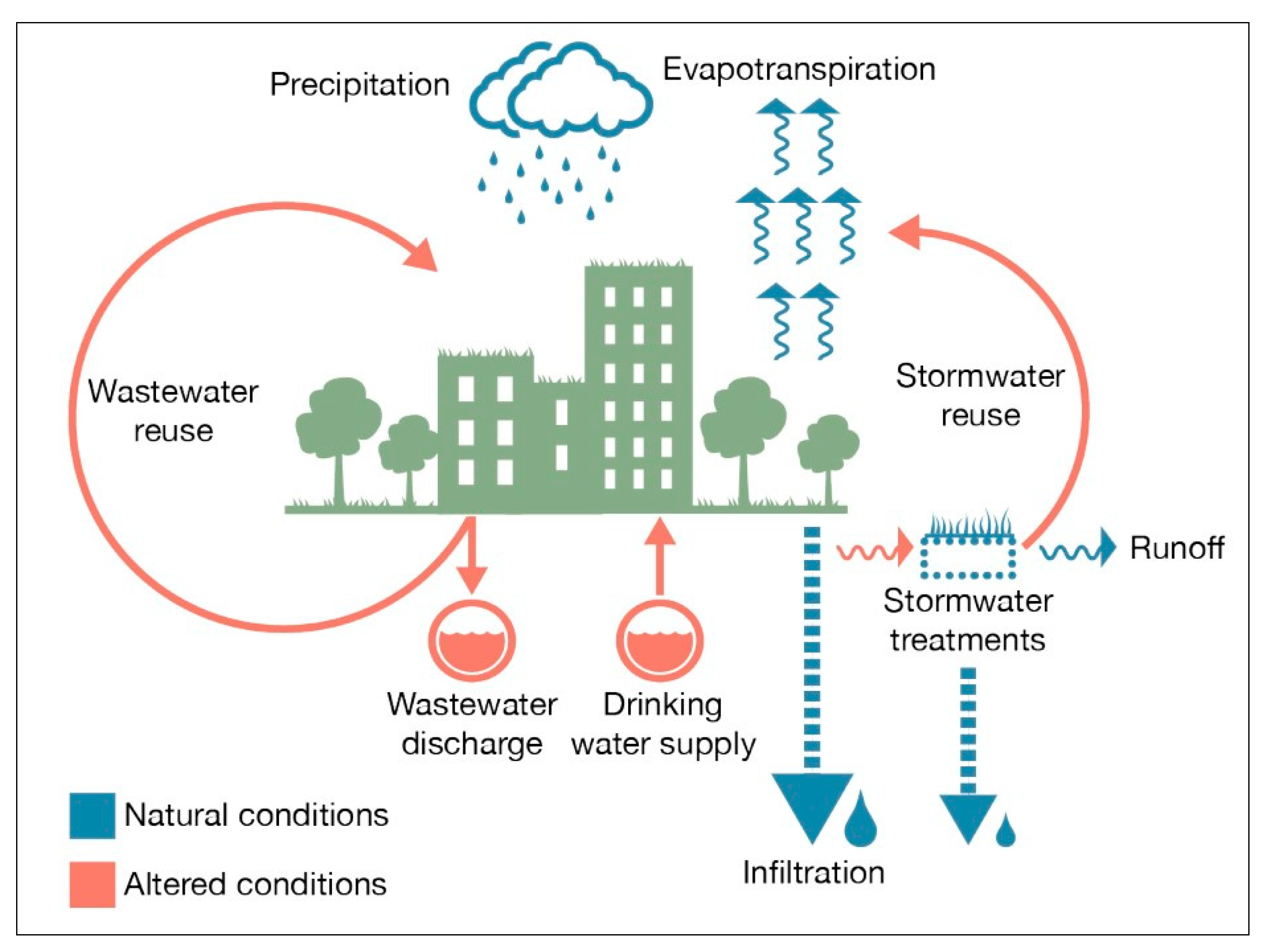

| Structural Layers | Specifications | Results |
|---|---|---|
| Pavement layer (concrete pavers + aggregate ASTM No. 89) | Thickness | 130 mm |
| Base layer material (aggregate ASTM No. 57) | Thickness | 100 mm |
| Porosity | 0.319 | |
| Void ratio | 0.47 | |
| Permeability | 0.011 m/s | |
| Subbase layer material (aggregate ASTM No. 4) | Thickness | 180 mm |
| Porosity | 0.348 | |
| Void ratio | 0.53 | |
| Permeability | 0.145 m/s | |
| Subgrade layer material (GP—gravels poorly graduated) | Subgrade strength | 201.4 MPa |
| Porosity | 0.275 | |
| Void ratio | 0.38 | |
| Permeability | 0 m/s |
| Return Period (Years) | Initial Water Pavement | Surface Flow | Storage Pavement | Infiltration Subgrade | Drainage Pipe | Surface Flow | Superficial Stagnation |
|---|---|---|---|---|---|---|---|
| 2 | 0.0 | 252.1 | 146.2 | 0.0 | 105.9 | 0.0 | 0.0 |
| 5 | 0.0 | 340.1 | 149.9 | 0.0 | 190.2 | 0.0 | 0.0 |
| 10 | 0.0 | 404.1 | 152.4 | 0.0 | 251.7 | 0.0 | 0.0 |
| 25 | 0.0 | 432.1 | 153.4 | 0.0 | 278.7 | 0.0 | 0.0 |
| 50 | 0.0 | 545.3 | 160.6 | 0.0 | 384.7 | 0.0 | 0.0 |
| 100 | 0.0 | 673.0 | 237.8 | 0.0 | 435.2 | 0.0 | 0.0 |
| Return Period (Years) | Initial Water Pavement | Surface Flow | Storage Pavement | Infiltration Subgrade | Drainage Pipe | Surface Flow | Superficial Stagnation |
|---|---|---|---|---|---|---|---|
| 2 | 0.0 | 252.1 | 146.2 | 0.0 | 105.9 | 0.0 | 0.0 |
| 5 | 0.0 | 340.1 | 152.2 | 0.0 | 187.9 | 0.0 | 0.0 |
| 10 | 0.0 | 404.1 | 198.4 | 0.0 | 205.7 | 0.0 | 0.0 |
| 25 | 0.0 | 432.1 | 225.4 | 0.0 | 206.7 | 0.0 | 0.0 |
| 50 | 0.0 | 545.3 | 332.5 | 0.0 | 212.8 | 0.0 | 0.0 |
| 100 | 0.0 | 673.0 | 448.8 | 0.0 | 222.3 | 0.0 | 1.9 |
| Storm Return Period (Years) | Rainfall Magnitude over 24 h (mm) | Satisfies Paver Infiltration Capacity | Satisfies Granular Infiltration Capacity | Satisfies Storage Goal | Satisfies Storage Capacity |
|---|---|---|---|---|---|
| 2 | 53 | Yes | Yes | Yes | Yes |
| 5 | 72 | Yes | Yes | Yes | Yes |
| 10 | 85 | Yes | Yes | Yes | Yes |
| 25 | 91 | Yes | Yes | Yes | Yes |
| 50 | 114 | Yes | Yes | Yes | Yes |
| 100 | 140 | Yes | Yes | Yes | Yes |
Disclaimer/Publisher’s Note: The statements, opinions and data contained in all publications are solely those of the individual author(s) and contributor(s) and not of MDPI and/or the editor(s). MDPI and/or the editor(s) disclaim responsibility for any injury to people or property resulting from any ideas, methods, instructions or products referred to in the content. |
© 2023 by the authors. Licensee MDPI, Basel, Switzerland. This article is an open access article distributed under the terms and conditions of the Creative Commons Attribution (CC BY) license (https://creativecommons.org/licenses/by/4.0/).
Share and Cite
Cacciuttolo, C.; Garrido, F.; Painenao, D.; Sotil, A. Evaluation of the Use of Permeable Interlocking Concrete Pavement in Chile: Urban Infrastructure Solution for Adaptation and Mitigation against Climate Change. Water 2023, 15, 4219. https://doi.org/10.3390/w15244219
Cacciuttolo C, Garrido F, Painenao D, Sotil A. Evaluation of the Use of Permeable Interlocking Concrete Pavement in Chile: Urban Infrastructure Solution for Adaptation and Mitigation against Climate Change. Water. 2023; 15(24):4219. https://doi.org/10.3390/w15244219
Chicago/Turabian StyleCacciuttolo, Carlos, Felipe Garrido, Daniel Painenao, and Andres Sotil. 2023. "Evaluation of the Use of Permeable Interlocking Concrete Pavement in Chile: Urban Infrastructure Solution for Adaptation and Mitigation against Climate Change" Water 15, no. 24: 4219. https://doi.org/10.3390/w15244219
APA StyleCacciuttolo, C., Garrido, F., Painenao, D., & Sotil, A. (2023). Evaluation of the Use of Permeable Interlocking Concrete Pavement in Chile: Urban Infrastructure Solution for Adaptation and Mitigation against Climate Change. Water, 15(24), 4219. https://doi.org/10.3390/w15244219









